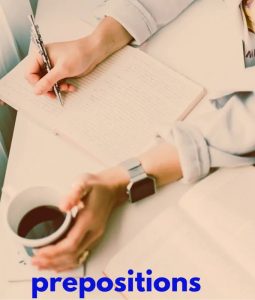Preposition
A preposition is one of the parts of speech, and it shows the relation of a noun and pronoun to other words in a sentence.
There are three types of prepositions: the preposition of time, the preposition of place, and the preposition of direction.
Preposition of time, answers when something happens or will happen, etc.
The preposition of place answers where the object or person is.
The preposition of direction shows the direction of something or someone.
Preposition of Time
At, on, in, for, since, by, during, with, until, till.
At, on, and in are also used as prepositions of place.
There are so many prepositions, but we will focus only on a few for each category.
In, On, and At
Using the above three prepositions, there is a simple trick or rule, which is that we move from general to specific, and the order is below.
In general
On in the middle
At specific
In is used for general periods; on is used for specific periods but not as specific as at is used for; and on is somewhere in the middle.
Uses of on, in, and at as Prepositions of Time
IN is used for general periods, for example.
In the future, she will be a doctor.
She worked hard in the past.
There are always exceptions to grammar rules, so this is also an exception.
In and At both can be used with a present, like at present, and in present, the rules of general and specific can work here as well, for example.
At present, I’m a student.
At is more specific than in.
Past and present are general periods, not specific ones because there are many years in the past, present, and future.
In is also used for years and months.
She was born in 1880.
Pakistan came into being in 1947.
She is in her 90s.
Months
She will visit her in January.
The school will remain closed in December.
We will move to our new home in October.
In is also used to talk about seasons. as the season is a big part of the year; therefore, it is a general time and has many months, for example.
In autumn, the leaves fall.
Flowers bloom in April.
To talk about the general part of the day, we use IN for example.
In the morning
In the evening
In the afternoon
Uses of the Preposition “ON”
On is used for surfaces, for example.
The girl is sitting on a chair.
The boy is on the roof of the house.
He is on a footpath.
ON is also used for dates and days, for example.
She was born on the 24th of November This School was founded on the 8th of June
On Monday we will be leaving
We are coming on Tuesday
ON is also used to talk about machines for example
She is on her computer
He is on mobile
On is also used for body parts when something touches your body or falls on your body for example
The juice fell on my leg
She kissed her daughter on the forehead
Uses of “AT”
At is used for a more specific time.
At is used for mealtimes and clock times for example
She goes to school at 7:30 a.m.
She will come at dinnertime
It is also used with night but sometimes preposition in is used with night.
In night is used when we talk about a specific time during the night but at night is used to indicate all night.
At is used with holidays for example We will meet at Christmas
When the day is used with holidays we use the preposition on and when just holidays are used we use the preposition at for example
We will meet on Christmas day
And
We will meet at Christmas
Now we will be talking of the same three prepositions for a place as well, what we discussed for the preposition of time, and it will have the same pattern as told above
Preposition IN is more general, ON is in the middle and IT is specific.
In is used for countries and cities for example
She lived in Mumbai for 3 years
I live in Pakistan
She lives in Quetta the capital of Balochistan
In is also used for enclosed spaces for example
I am going in a car
They are in a house
She is in her room
Car, house, and room are enclosed spaces, but there are a few exceptions in this case which are as follow
We do not use in with trains, buses, planes, and ships instead of in we use on with these vehicles for example
They are on a plane
She is on the bus
He’s on a train
I will be on a ship
One thing that you can note down is that these four vehicles are public transport, and secondly, these are vehicles where one can walk but we can’t walk in a car.
We use the preposition IN with the word house and At with home.
We also use IN with the office for example in the office but AT is used with work because work is not a place but work is a concept and the office is the place.
Preposition IN sounds more general whereas preposition AT sounds specific.
Therefore we used AT with home and IN with house because home sounds specific and house general.
Sometimes different prepositions are used with the same word for example with school at and in both can be used depending on the purpose.
A school is a place built for learning, and it is a building, but learning is a concept or activity so if there is a student who is in his class we would say he is at school but if someone goes to school for repairing we would say he is in the school because the purpose of school is to teach not repair.
The same is the case for bed as the bed was created to sleep and to use during your illness, so if the bed is used for the same purpose then we say in bed, but when the bed is used for other purposes for which it was not meant like reading, and watching TV then we use on the bed.
Preposition of direction
The preposition of direction shows the direction of someone or something, there are many prepositions for direction but we will be focusing on just two of them
TO
And
INTO
Uses of 2
To is used to show movement from one place to another for example
He is going to the bakery
She is flying to Karachi next week
The word Arrived also shows movement but the preposition TO is never used with arrived instead of TO we use AT with it.
TO is also used in some phrases for example
She has improved to a great extent
Here the movement is from something less toward great
She is right to some extent
TO is also used to start and end a discussion for example
To start I would like to say…
To conclude the impact is great
Into uses
Into is used for transformation for example
Eliza a poor, uneducated flower girl was transformed into a duchess
Into is also used for impact for example
She accidentally walked into the wall
Into is also used to indicate the inside of something for example for
Pour the water into a glass
To conclude it would be great to mention that these are few prepositions but if we focus on these we c
an learn them and can improve much regarding prepositions.



